|
canoe
is a relatively small boat,
typically human-powered, but also commonly sailed. Canoes are pointed at
both ends and usually open on top, but can be covered. For the activity
of using a canoe in sport or for recreation, see canoeing.
In
its human-powered form, the canoe is propelled by the use of paddles,
with the number of paddlers depending on the size of canoe. Paddlers
face in the direction of travel, either seated on supports in the hull,
or kneeling directly upon the hull. In this way paddling a canoe can be
contrasted with rowing, where the rowers face away from the direction of
travel. Paddles may be single-bladed or double-bladed.
Sailing
canoes (see Canoe Sailing) are propelled by means of a variety of
sailing rigs. Common classes of modern sailing canoes include the 5m²
and the International 10m² Sailing canoes. The latter is otherwise
known as the International Canoe, and is one of the fastest and oldest
competitively sailed boat classes in the western world.
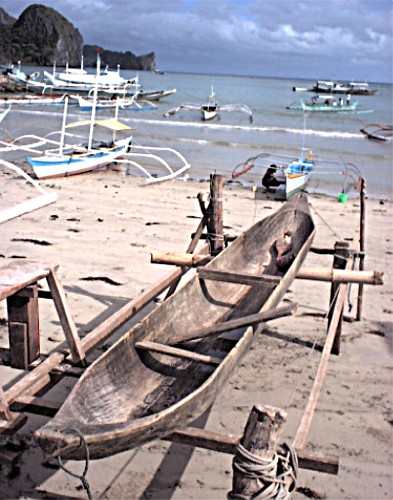
Traditional
island canoe
at El Nido, Philippines
Ambiguity
over the word Canoe
Confusingly,
the sport of canoeing, organised at the international level by the
International Canoe Federation, uses the word canoe to cover both
canoes as defined here, and kayaks (see below for a brief description of
the differences between a kayak and a canoe). In fact, the sport of
canoe polo is exclusively played in kayaks. This confusing use of canoe
to generically cover both canoes and kayaks is not so common in North
American usage, but is common in Britain, Australia and presumably many
parts of the world, both in sporting jargon and in colloquial speech. In
these circumstances, the canoe as defined here is sometimes referred to
as an open, Canadian, or Indian canoe, though these
terms have their own ambiguities.
A
'canoe' in this ambiguous sense is a paddled vessel in which the user
faces the direction of travel.
Design
and construction
Parts
of a canoe
-
Bow
-
Stern
-
Hull
-
Seat
(whitewater canoes may have a foam 'saddle' in place of a seat)
-
Thwart
- a horizontal crossbeam near the top of the hull
-
Gunwale
(pronounced gunnel) - the top edge of the hull
-
Deck
(under which a floatation compartment or foam block may be located
which prevent the canoe from sinking if capsized or swamped)

Optional
features in modern canoes
-
Yoke
- a thwart across the centre of the boat to allow one person to
carry the canoe, and is sometimes molded to the shape of the
shoulders.
-
Keel
-
Floatation
bags - inflatable air bags to prevent swamping the canoe in rapids
-
Spraydeck
- cover to prevent water entering the canoe
The
portion of the hull between the waterline and the top of the gunwale is
called freeboard.
Canoe
materials
The
earliest canoes were made from natural materials:
-
Early
canoes were wooden, often simply hollowed-out tree trunks. This
technology is still practiced in some parts of the world. Modern
wooden canoes are typically strip-built by woodworking craftsmen.
Such canoes can be very functional, lightweight, and strong, and are
frequently quite beautiful works of art.
-
Many
indigenous peoples of the Americas built canoes of tree bark, sewn
with tree roots and sealed with sap. The indigenous people of the
Amazon commonly used Hymenaea trees. In temperate North America,
cedar was used for the frame and Birch bark for the hull, with
charcoal and fats mixed into the sap.
Modern
technology has expanded the range of materials available for canoe
construction.
-
Wood-and-canvas
canoes are made by fastening an external canvas shell to a wooden
hull formed with cedar planks and ribs. These canoes evolved from
birch bark construction but the transition record is not clear. In
areas where birch bark was scarce, other natural materials such as
cedar had to be used and there was known success in patching birch
bark canoes with canvas or cloth because these materials were
readily available. Efforts were made in various locations to improve
upon the bark design such as in Peterborough, Ontario, Canada
where rib and plank construction was used by the Peterborough Canoe
Company, and in Old Town, Maine in the U.S
where similar construction was used by the Old Town Canoe Company.
-
Aluminum
canoes were first made by the Grumman company in 1944, when demand
for airplanes
for World War II
began to drop off. Aluminum allowed a lighter and much stronger
construction than contemporary wood technology. However, a capsized
aluminium canoe will sink unless the ends are filled with flotation
blocks.
-
Plywood
canoes are sealed with epoxy resin, or the inferior but cheaper
polyester resin, and reinforced with glass fibre tape or cloth.
-
Composites
of fiberglass,
Kevlar and carbon fiber are used for modern canoe construction.
These compounds are light and strong, and the maneuverable, easily
portaged canoes allow experienced paddlers access to some of the
most remote wilderness areas.
-
Royalex
is another modern composite material that makes an extremely
flexible and durable hull suitable, in particular, for whitewater
canoes. Royalex canoes have been known to pop back into their
original shape with minimal creasing of the hull after having been
wrapped around a rock in strong river currents.
-
Polyethylene
is a cheaper and heavier material used for modern canoe
construction.
Depending
on the intended use of a canoe, the various kinds have different
advantages. For example, a canvas canoe is more fragile than an aluminum
canoe, and thus less suitable for use in rough water; but it is quieter,
and so better for observing wildlife. However, canoes made of natural
materials require regular maintenance, and are lacking in durability.
Shape
Many
canoes are symmetrical about the centerline, meaning their shape can be
mirrored along the center. And theoretically they should handle the same
whether paddling forward or backward. But some advanced designs are
asymmetrical, usually placing the widest part of the canoe slightly
farther back. This increases the ability to 'track' in a straight line
without compromising the manoeuvrability much.
A
traditionally shaped canoe, like a voyageur canoe, will have a tall
rounded bow and stern. Although tall ends tend to catch the wind, they
serve the purpose of shedding waves in rough whitewater or ocean travel.
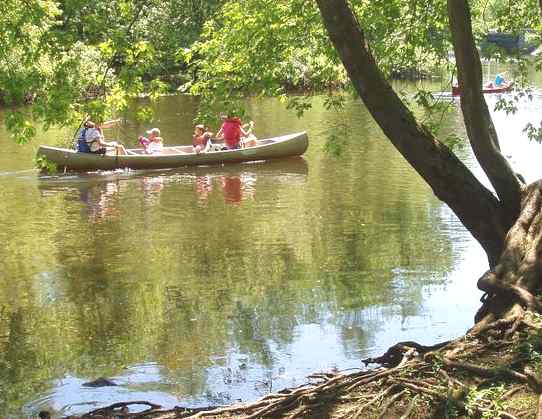
Canoe
on Concord river Massachusetts
Cross
section
The
shape of the hull's cross section and bottom determines how stable the
canoe is in different conditions. A flat-bottomed canoe has excellent
initial stability, but if tilted beyond a threshold, becomes unstable
and may capsize. It is suitable for flatwater but it will rock more with
larger waves.
A
rounded-bottom canoe exhibits poor resistance to tilt. Its initial
stability is poor, but its final stability is better. Furthermore,
because of the optimal volume to surface ratio, it will have less draft
than any other shape, making a canoe with a rounded bottom suitable for
racing. Round-bottomed designs are also able to go over obstructions
more easily, due to a small area of contact with the obstruction.
In
between these two shapes is the more common shallow-arc bottom. It
combines reasonable initial stability with a reasonable secondary
stability. Similar is the tumblehome hull which has the top potion of
the hull curving back in slightly, providing even more secondary
stability when tilting.
Some
canoes have a shallow-vee bottom, where the hull centerline forms a
ridge like a shallow "V". It will behave similar to a
shallow-arc bottom but its volume to surface ratio is worse.
Modern
manufactures may combine a variety of cross sections to suit the canoe's
purpose.
Keels
Keels
on canoes will slightly increase the ability to 'track' in a straight
line, but decrease the ability to turn quickly to avoid an obstacle.
Consequently, canoes with a keel are better suited for lake travel,
especially when traveling on open water with crosswinds. However, the
hull has a larger cross-section than the keel, and has therefore a
greater effect on a canoe's path through the water. Keels and "Vee"-bottoms
are undesirable for whitewater because they increase the draft.
In
aluminum canoes, small keels occur as manufacturing artifacts when the
two halves of the hull are joined. In wood-and-canvas canoes, keels are
rub-strips to protect the boat from rocks and as they are pulled up on
shore. Plastic canoes feature keels to stiffen the hull and allow
internal tubular framing to lie flush with the sole of the canoe.
Rocker
Some
hulls protrude downward in the middle and rise upward toward the bow and
stern; this is called "rocker". More rocker (greater
curvature) affects handling in the opposite way from omitting a keel: it
improves maneuverability at the expense of tracking. Specialized canoes
for whitewater play have an extreme rocker and therefore allow quick
turns and tricks.
Types
of canoes
In
the past, people around the world have built very different kinds of
canoes, ranging from simple dugouts to large outrigger varieties. More
recently, technologically advanced designs have emerged for particular
sports.
Traditional
designs
Early
canoes in many parts of the world were dugouts, formed of hollowed logs.
In
the Pacific
Islands, dugout canoes are very large, made from whole mature trees and
fitted with outriggers for increased stability in the ocean, and were
once used for long-distance travel. Such are the very large waka used by
Māori who ventured to New
Zealand many centuries ago. Such vessels carried 40 or 50 warriors
in sheltered waters or smaller numbers thousands of miles across the
Pacific ocean. In Hawaii,
canoes are traditionally manufactured from the trunk of the koa tree.
They typically carry a crew of six: one steersman and five paddlers.
In
the temperate regions of eastern North America, canoes were
traditionally made of a wooden frame covered with bark of a birch tree,
pitched to make it waterproof. Later, they were made of a wooden frame,
wood ribs, other wood parts (seats, gunwales, etc.) and covered with
canvas, sized and painted for smoothness and watertightness. On the west
coast of North America, large dugout canoes were used in the Pacific
Ocean, even for whaling.
Modern
designs
Canoe
types are usually categorized by the intended use. Many modern canoe
designs are hybrids (a combination of two or more designs, meant for
multiple uses). The purpose of the canoe will also often determine the
materials used. Most canoes are designed for either one person (solo) or
two persons (tandem), but some are designed for more than 2 persons.
-
Touring
canoe (or tripping canoe) - made of lighter materials and built
for comfort and cargo space; usually a more traditional design.
-
Prospector
canoe - a popular type of touring canoe marked by a
symmetrical hull and a continuous arc from bow to stern; made in
a variety of materials.
-
Long
Distance Touring canoe - A cockpit has many unique
advantages. The main one is being able to make the gunnel line
lower and narrower so the paddler can reach the water better. At
the same time a cockpit makes the rim of the boat higher and
therefore the boat is dryer. With the rounded hull shape and
full ends there is nothing for turbulent water to work on.
-
Whitewater
canoe (or river canoe) - no keel and increased rocker for
manuverability. The hulls are typically made of tough man-made
materials, such as ABS, for strength. Often extra internal lashing
points are present to secure floatation bags, harness, and spraydeck.
Some canoes are decked and look very much like a kayak, but are
still paddled with the paddler in a kneeling position and with a
single bladed paddle.
-
Square
stern canoe - asymmetrical canoe with a squared off stern for
the mounting of an outboard motor; meant for lake travel or fishing.
-
Racing
canoe (or sprint canoe) - purpose-built racing canoe for use in
racing on flat water. To reduce drag, they are built long and with a
narrow beam, which makes them very unstable. A 1-person sprint canoe
is 5.2 meters or 17 feet long. Sprint canoes are paddled kneeling on
one knee, and only paddled on one side; in a C-1, the canoeist will
have to j-stroke constantly to maintain a straight course. Marathon
canoe races use a similar narrow boat.
-
Inflatable
canoe - similar in construction and materials to other
inflatable boats but shaped like a canoe; meant for serious
whitewater; usually difficult to use for flatwater travel.
Differences
from other paddled boats
-
Kayak
- The main difference between a kayak and a canoe is that a kayak is
a closed canoe meant to be used with a double-bladed paddle, one
blade on each end, instead of a single bladed paddle. The
double-bladed paddle makes it easier for a single person to handle a
kayak. Kayaks are more commonly enclosed on top with a deck, making
it possible to recover from a capsize without the kayak filling with
water in most cases, although there are also closed canoes, which
are common in competition. The deck is an extension of the hull,
with a special sheet called a spraydeck sealing the gap between deck
and the paddler.
-
Rowboat
- not considered a canoe, since it is propelled by oars resting in
pivots on the gunwales. A single rower works 2 oars, and sits with
his or her back toward the direction of travel. Some rowboats, such
as a River Dory or a raft outfitted with a rowing frame are suitable
for whitewater.
-
Adirondack
guideboat - a rowboat that has similar lines to a canoe. However
the rower sits closer to the bilge and uses a set of pinned oars to
propel the boat.
-
Sit-on-tops
- more akin to kayaks in design, handling, and propulsion (see
Kayak#Sit-on-tops).
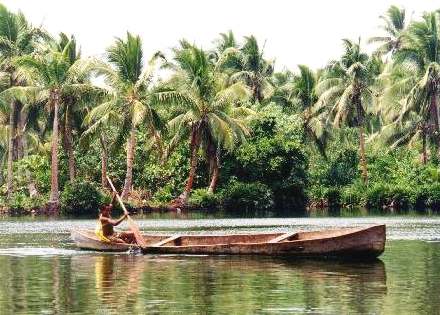
Dugout canoe of pirogue type in the Solomon Islands
Use
Canoes
have a reputation for instability, but this is not true if they are
handled properly. For example, the occupants need to keep their centre
of gravity as low as possible. Canoes can navigate swift-moving water
with careful scouting of rapids and good communication between the
paddlers.
When
two people occupy a canoe, they paddle on opposite sides. For example,
the person in the bow (the bowman) might hold the paddle on the
port side, with the left hand just above the blade and the right hand at
the top end of the paddle. The left hand acts mostly as a pivot and the
right arm supplies most of the power. Conversely, the sternman
would paddle to starboard, with the right hand just above the blade and
the left hand at the top. For travel straight ahead, they draw the
paddle from bow to stern, in a straight line parallel to the gunwale.
A
trick called "gunwale bobbing" allows a canoe to be propelled
without a paddle. The canoeist stands on the gunwales, near the bow or
the stern, and squats up and down to make the canoe rock backward and
forward. This propulsion method is inefficient and unstable.
Steering
The
paddling action of two paddlers will tend to turn the canoe toward the
opposite side that on which the sternman is paddling. Thus, steering is
particularly important, particularly because canoes have flat-bottomed
hulls and are very responsive to turning actions. Steering techniques
vary widely, even as to the basic question of which paddler should be
responsible for steering.
Among
experienced white water canoeists, the sternman is primarily responsible
for steering the canoe, with the exception of two cases. The bowman will
steer when avoiding rocks and other obstacles that the sternman cannot
see. Also, in the case of backferrying, the bowman is responsible for
steering the canoe using small correctional strokes while backpaddling
with the sternman.
Among
less-experienced canoeists, the canoe is typically steered from the bow.
The advantage of steering in the bow is that the bowman can change sides
more easily than the sternman. Steering in the bow is initially more
intuitive than steering in the stern, because to steer to starboard, the
stern must actually move to port. On the other hand, the paddler who
does not steer usually produces the most forward power or thrust, and
the greater source of thrust should be placed in the bow for greater
steering stability.
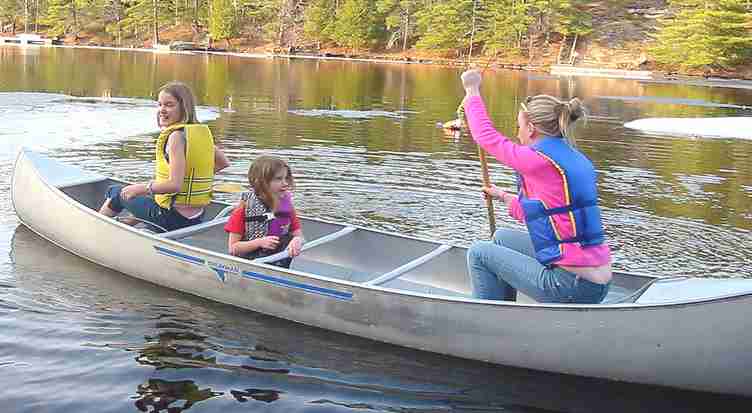
Paddle
strokes
Paddle
strokes are important to learn if the canoe is to move through the water
in a safe and precise manner. Categorizing strokes makes learning them
easier. After the strokes are mastered, they can be combined or even
changed so that handling the canoe is smooth and done in an efficient,
effective, and skillful manner. Here are the main ones:
-
The
cruising stroke or forward stroke is the easiest
stroke and is considered to be the foundation of all the other
strokes. It is used mainly by the bowman to simply propel the canoe
forward without turning. The paddle blade is brought forward along
the side of the canoe, dipped into the water, and drawn back. The
paddle should be drawn straight back rather than following the
gunwale's curvature. The back stroke is essentially the same
movement, but done in reverse. The back face of the blade is used in
this case. This stroke is used to make the canoe go backward or to
stop the canoe.
-
Advocates
of steering in the stern often use the J-stroke, which is so
named because, when done on the port side, it resembles the letter J.
It begins like a standard stroke, but towards the end, the paddle is
rotated and pushed away from the canoe with the power face of the
paddle remaining the same throughout the stroke. This conveniently
counteracts the natural tendency of the canoe to steer away from the
side of the sternman's paddle. This stroke is used in reverse by the
bowman while backpaddling or backferrying in white water.
-
A
less elegant but more effective stroke which is used in the stern is
the Superior stroke, more commonly referred to as the goon
or rudder stroke. Unlike the J-stroke in which the side of
the paddle pushing against the water during the stroke (the power
face) is the side which is used to straighten the canoe, this stroke
uses the opposite face of the paddle to make the steering motion. It
is somewhat like a stroke with a small pry at the end of it. This
stroke uses larger muscle groups, is preferable in rough water and
is the one used in white water. It is commonly thought to be less
efficient than the J-stroke when paddling long distances
across relatively calm water.
-
Another
stroke which may be used by either the bow or stern paddler is the pry
stroke. The paddle is inserted vertically in the water, with the
power face outward, and the shaft braced against the gunwale. A
gentle prying motion is applied, forcing the canoe in the opposite
direction of the paddling side.
-
The
running pry can be applied while the canoe is moving. As in
the standard pry, the paddle is turned sideways and braced against
the gunwale, but rather than forcing the paddle away from the hull,
the paddler simply turns it at an angle and allows the motion of the
water to provide the force.
-
The
draw stroke exerts a force opposite to that of the pry. The
paddle is inserted vertically in the water at arm's length from the
gunwale, with the power face toward the canoe, and is then pulled
inward to the paddler's hip. A draw can be applied while moving to
create a running or hanging draw.
-
The
cross-draw stroke is a bowman's stroke that exerts the same
vector of force as a pry, by moving the blade of the paddle to the
other side of the canoe without moving the paddler's hands. The arm
of bottom hand crosses in front of the bowman's body to insert the
paddle in the water on the opposite side of the canoe some distance
from the gunwale, facing towards the canoe, and is then pulled
inward while the top hand pushes outward. The cross-draw is much
stronger than the draw stroke.
-
The
sweep is unique in that it steers the canoe away from the
paddle regardless of which end of the canoe it is performed in. The
paddle is inserted in the water some distance from the gunwale,
facing forward, and is drawn backward in a wide sweeping motion. The
paddler's bottom hand is choked up to extend the reach of the
paddle. In the case of the bowman, the blade will pull a
quarter-circle from the bow to the paddler's waist. If in the stern,
the paddler pulls from the waist to the stern of the canoe. Backsweeps
are the same stroke done in reverse.
-
Complementary
strokes are selected by the bow and stern paddlers in order to safely
and quickly steer the canoe. It is important that the paddlers remain in
unison, particularly in white water, in order to keep the boat stable
and to maximize efficiency.
There
are some differences in techniques in how the above strokes are
utilized.
-
One
of these techniques involves locking or nearly locking the elbow,
that is on the side of the canoe the paddle is, to minimize muscular
usage of that arm to increase endurance. Another benefit of this
technique is that along with using less muscle you gain longer
strokes which results in an increase of the power to stroke ratio.
This is generally used more with the 'stay on one side' method of
paddling.
-
The
other technique is generally what newer canoeists use and that is
where they bend the elbow to pull the paddle out of the water before
they have finished the stroke. This is generally used more with the
'switch sides often' method of paddling.
-
The
stay on one side method is where each canoeist takes opposite
sides and the sternman uses occasional J-strokes to correct
direction of travel. The side chosen is usually the paddlers'
stronger side, since this is more comfortable and less tiring. Some
canoeists do, however, switch sides after twenty to thirty minutes
or longer as a means of lessening muscle fatigue.
-
The
switch sides often method (also called hit and switch,
hut stroke, or Minnesota switch) allows the canoeists
to switch sides frequently (usually every 5 to 10 strokes, on a
vocal signal, commonly "hut") to maintain their heading.
This method is the fastest one on flat water and is used by all
marathon canoeists in the US and Canada. The method works well with
bent-shaft paddles. Racer/designer Eugene Jensen is credited with
the development of both "hit and switch" paddling and the
bent shaft paddle.
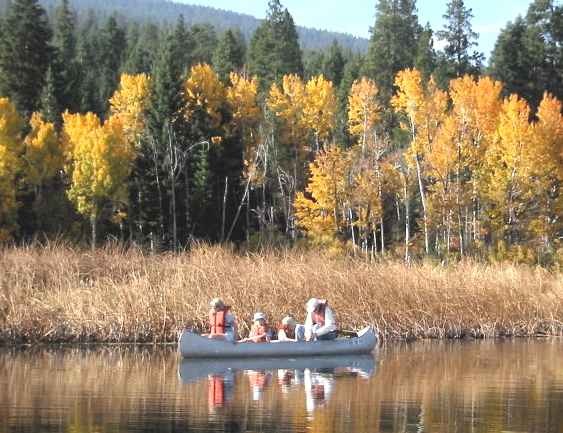
Canoe
trail Klamath National Wildlife Reserve
Setting
poles
On
swift rivers, the sternman may use a setting pole. It allows the canoe
to move through water too shallow for a paddle to create thrust, or
against a current too quick for the paddlers to make headway. With
skillful use of eddies, a setting pole can propel a canoe even against
moderate (class III) rapids.
CANOEING
LINKS:
.......
The World in Your Hands

SolarNavigator
began life in 1990s as an attempt to prove that the world could be
navigated on solar power alone in a SWATH
boat. Since then the hull design has been refined to a SWASSH
configuration - and electronics have developed to the stage where this
vessel could be the first true fully autonomous Robot Ship - ideal for
extended 365 day a year hydrographic surveying
and other persistent ocean monitoring and surveillance.
|






